#PerformanceData
Explore tagged Tumblr posts
Text
A business that doesn’t track behavior will be surprised when it collapses. TDZ Pro pays attention.
#VideoAnalytics#TDZPro#RemoteSignals#PerformanceData#RemoteStability#BusinessWarningSigns#MetricsMatter
0 notes
Text
Price: [price_with_discount] (as of [price_update_date] - Details) [ad_1] Stands for "Compact Disc premium Brand Recordable." CD-R discs are blank CDs that can record data written by a CD burner. The word "recordable" is used because CD-Rs are often used to record audio, which can be played back by most supported CD players. However, many other kinds of data can also be written to a CD-R, so the discs are also referred to as "writable CDs." Premium Brand CD-R with Jewel Case Unbeatable performance Data -Photo - Movies - Music your memories [ad_2]
0 notes
Photo

#muschi
#BœʤChiʧ #032k
#muffy
#horizontale #horizontals
#farbenschisse #colorshits
#excrement #shit #veil #shroud #haze #durt #vogel #scheisse #kacke #dreck #kot #schiss #beach #bird #action #painting #performance #collage #art #foto #image #kunst #bild #schœn #beauty
#photo #release #edition #data #free #healthy #homeland #live #love #life #live #interaction
#free#beach#burd#muffy#excrement#action#peinting#session#art#beauty#collage#release#edition#performancedata#set
0 notes
Text
Price: [price_with_discount] (as of [price_update_date] - Details) [ad_1] SAMSUNG T7 Portable SSD 500GB - Up to 1050MB/s - USB 3.2 External Solid State Drive, Blue (MU-PC500H/AM) *SAMSUNG RECOMMENDS users to download the latest firmware update via the included Portable SSD Software 1.0 to ensure optimal performance Data transfer speed may vary depending on the user’s PC environment and the types of data being transferred. USB 3.2 Gen2 and UASP support are required for maximum transfer speed (1,050MB/s)** **SAMSUNG RECOMMENDS the usage of the included USB Type-C to C and USB Type-C to A cables. Non-original cables may cause performance degradation due to the varying internal resistance and maximum allowable currency BUILT STRONG & SECURE: Shock-resistant and withstands drops from 6ft. ADVANCED HEAT CONTROL: DYNAMIC THERMAL GUARD (DTG) TECHNOLOGY protects the T7(T7 Touch) from overheating by automatically slowing down data transfer if necessary. DTG technology enhances product safety and reliability by preventing the T7(T7 Touch) from reaching an excessively high temperature PASSWORD SECURITY [ad_2]
0 notes
Text
Underused Tactics and Overlooked Metrics in E-Commerce
There are plenty of impressive tactics or metrics that aren’t often discussed, not necessarily because they aren't important, but because it's easy to get locked into the rhythm of simply reporting on traffic and sales.
To change things up, let's look into some other areas we can optimize to improve the organic performance of e-commerce websites, and some underrated but useful metrics that can help you report on that performance.
Tactics to optimize and measure your e-commerce website performance
Data scraping for SEO and analytics
Data scraping is very useful when you want to retrieve, or scrape, elements from a page for further analysis or optimization.
Most people know that you can scrape common webpage elements such as publication date, author name, or price, but what about more specific aspects of e-commerce websites, and what can we use them for? Product pages have unique attributes that you can scrape, such as “add to basket” type buttons or even product schema; below, I’ll talk about how you can scrape breadcrumb data.
Scraping the breadcrumbs
In short, breadcrumbs are a trail that shows users where they are in the structure of a website, and they are especially useful for navigation and internal linking.
By using crawling tools to scrape data from the breadcrumbs, you can have a more complete view of the site as a whole, and it allows you to identify any trends.
Below, you can see that it's possible to extract breadcrumb data as a series of values by using XPath, and setting this up as a custom field. This allows you to see the data as a separate field once a crawl is finished.

Evaluating your page templates
The typical page templates that you'd expect to see on an e-commerce site include:
Homepage
Information pages (e.g. about us, delivery information, terms and conditions)
Product pages
Category pages
Navigational landing pages
Blogs / guides
Payment / cart pages
Help/support area
A large e-commerce website may have a significant number of product and category pages. These are the pages that generate the most conversions and transactions, so it is tremendously helpful to know how you can break these down into more manageable chunks.
For a website with millions of pages, it is practically impossible to crawl the whole site; your crawler will run out of memory and space, or it could take weeks to finish, and that’s just not feasible for most of us. This is where segmentation comes in. Segmenting your website also allows you to focus on one area of the site before moving on to another.
A common tactic for websites the size of Target or Tesco is to focus on one category per quarter, and then move on to another area of the site. It's through segmentation that they're able to do this.
Segmenting product pages
There are many different ways you can segment a website, and focusing on your products can help you start seeing improvements in revenue sooner than if you were to focus on other areas of the site.
With product pages, a good tactic is to look for URL patterns, such as those that end in .html or contain /product/.
It's also possible to get additional dimensions from your product pages by segmenting your products by their stock status. Separating pages by whether or not a product item is in stock or not can help you determine:
How much traffic is going to out-of-stock products.
Whether availability and out-of-stock products are affecting product conversion rates.
Get a granular view of what page engagement metrics are affected by stock availability.
When scraping this data, you can look for specific on-page elements such as missing prices or an Unavailable / Out of Stock message on your pages.
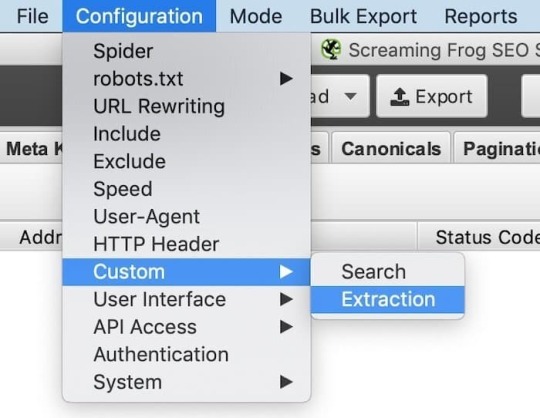
One method of doing this would be to extract the product availability property from a site’s schema markup. If you’re using Screaming Frog, you can access the Custom Extraction feature in the Configuration dropdown under Custom > Extraction,and then set up your extraction rules.
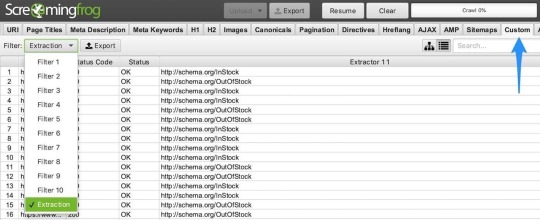
Segmenting category pages
Segmenting category pages allows you to find any categories that have hundreds of products and could benefit from being split into subcategories.
Category pages don't always have specific URL patterns, and they differ from one CMS to another, but you can look out for those that contain /category/ or /shop/. Another good option is to look for unique attributes, such as those with text showing X of Y results or pages with options for sorting product results.
Structured data markup
We saw earlier that you could scrape pages for instances of product data to identify product pages. But before we move on, we need to ensure we understand what structured data or schema markup is and how it can benefit e-commerce websites.
Product markup
Product markup provides more information about your products directly in the SERPs when your audience searches for them. Product markup can also mean your products are more eligible for rich results, such as carousels, images, and other non-textual elements.
The product schema might look something like this:

Once added, product schema allows your audience to see valuable information about your products before they even land on your page, improving your CTR! We can see Walmart has added product schema to their products in the two examples below:
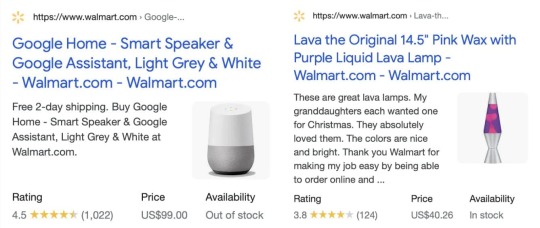
Star ratings in search results
The more positive reviews your products have, the more likely customers will be to visit your website and buy your products, especially when compared to your competitors.
Star ratings can be pulled in from your product markup through third-party tools such as Trustpilot or Reevoo, or from on-page customer reviews.

We see this when looking at these searches for Dell laptops. Realistically, which links are you more likely to click on as a customer: those with high star ratings or those with seemingly no rating at all?
Optimizing crawl budget for e-commerce
There will likely be pages on your website that are useful to existing customers, such as thank you pages after placing an order, logged-in account pages, etc. However, these pages won’t be the most important for new users looking to find you or your products on search.
It costs Google time and money to crawl our sites, so they need to budget accordingly. By managing this crawl budget, we guide search engines toward our most valuable and essential pages.
Noindexing
We don't need to index every page on our websites.
It’s entirely acceptable to meta-noindex or disallow certain pages in the robots.txt file — in fact, it’s expected. This is because indexing everything could mean that Google might not crawl all of our pages, so they might not index all of our content. This would be a problem, as it could mean some of our high-value, top-converting pages might not rank organically.
That said, we shouldn’t be noindexing vast chunks of an e-commerce website without proper research. By noindexing huge chunks, we're missing out on the ranking potential for key search behavior, e.g. locations, product sizing, etc.
Use of URL parameters
As users or owners of e-commerce websites, we’re likely familiar with URL parameters. Common areas that we see these parameters include:
Faceted navigation
Product sorting
Faceted navigation pages and product sorting options are typically blocked in robots.txt files, but it’s a good idea to find out how many of those pages Google is still serving to searchers. We can do this in our chosen crawling tool by selecting the option to ignore robots.txt rules. Alternatively, you can segment landing page session data in Google Analytics by URLs with parameters to see how many of those parameter pages are being served to users. Then, the session data will be used to show how many visits those pages are getting.
It may seem counterintuitive to do this, but these pages tend not to have unique on-page content, as they will have duplicated titles, headings, or body content, which means you could be missing out on other, more essential pages ranking for relevant keywords.
Measuring site speed across templates
With large e-commerce websites, it doesn't make sense to simply test one or two pages and take that as a site speed reading across the entire website. Each page template is built differently. One type of page can load faster than another — even if all other test parameters are the same.
Testing site speed across multiple page templates
As discussed earlier, there are many different template types that can make up a successful website. Testing a selection of pages from each of these templates is recommended to get the best picture of the load time performance of your site.
An excellent way to do this is through using the PageSpeed Insights API and connecting it to Screaming Frog or using cloud tools such as OnCrawl or Site Bulb, which will test the speed of each page on your website as it crawls.
To do this in Screaming Frog, go to “Configuration”. In “API Access”, select “PageSpeed Insights”, and there you will see fields to include the API key.

Once done, in the “Metrics” section, you can select both the device that you want to track and the reports, metrics, etc., that you are interested in extracting page speed information. In the example below, we have selected Crux Data and TTFB (Time to First Byte) and LCP and FCP data. Although the crawl may take longer to complete, this information should now appear alongside the URLs in the final crawl.

Choosing your testing location
There are various tools you can use to test your site speed, such as PageSpeed Insights, WebPageTest, and GTmetrix, and most of these do allow you to set your testing location.
It's important to test your e-commerce site from a location close to where your data centre is located (where your website is hosted), as well as one that is further away. Doing this lets you get an idea of how your real customers are experiencing your store.
If you have a CDN installed, such as Cloudflare, this is also useful, as it allows you to see how much of an impact the CDN is having on your website and how it helps your site load more quickly.
Wherever you decide to test from, remember to keep these locations the same each time you test so you can get accurate results.
Understanding caching and how it influences site speed
If your e-commerce website has caching installed, it’s even more important to test your pages more than once. This is because, on the first test, your page may not have loaded over the cache yet. Once it does, your results will likely be much faster than what you saw on your first test.
With or without caching installed, I would recommend testing each page template around three times for both mobile and desktop devices to get a good measurement and then calculate the average..
Common e-commerce website mistakes
Understanding the common problems that e-commerce websites make is valuable for learning how to avoid them on your own website, as the reasons some tactics remain underused come down to these errors.
Faceted navigation for e-commerce
Whatever your e-commerce site sells, it should be easy to navigate, with sensible menus and navigation options that clearly tell visitors what they will see when they click.

You can see this on the Boohoo website, a prominent fashion retailer in the UK. This image shows the women's dresses navigation, but you can see how it is broken down by type of dresses, dresses by occasion, colour, how they fit, and even by current fashion trends. Users are able to navigate directly to the subcategories they need.
Good website architecture matters
The importance of good architecture cannot be underestimated and should be centered around the core actions you want people to complete. Ideally, it would be best if you attempted to set up a site with the homepage, followed by the subsequent categories, subcategories, and then the products underneath.
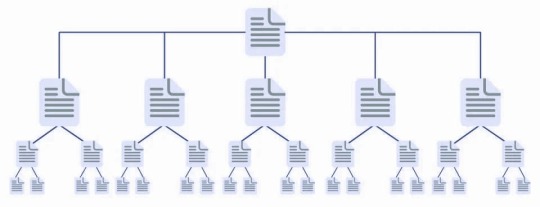
Boohoo has followed this same ideology with their architecture — as trends change and new lines of dresses are added, they can quickly expand and edit the architecture as needed.
Keeping it simple and scalable is the key to setting up good architecture. As your store grows, you will likely add more categories and products, so you need to be able to do this efficiently. You should attempt to keep important pages less than three clicks from the homepage and implement keyword research processes to create highly relevant page URLs and subdirectories.
You want people to buy your products, so don't make it difficult for them. You can then have other areas on the site for content silos and blogs that link to the various categories and products around the site.
Creating effective product pages
The product page design shouldn't detract from the shopping experience, and the product information should be as "friendly" and accessible as possible.
Try to use the product information you have available in your Product Information Management (PIM) system. Ensure that your sizes, measurements, colors, prices, and other details are easy to find, read, and understand. These details are even more vital if you happen to sell products that others also offer. If you're not including any sizes, but your competitors are, you're increasing your chances that potential customers can choose to buy from them instead. If you’re targeting multiple countries, consider whether you need to include your measurements in imperial, metric, or both. Information should be localized where relevant.
Some top ways to ensure you always include enough information and avoid thin content on your product pages are to:
Start with a 50-100 word introduction: Think about what the product does and who needs it? One way to do this can be seen in the example from Apple below.
List the critical features and technical specifications in bullet format.
Include a “deep dive” section: Write a detailed product description with use cases, relevant awards the product may have won, benefits of the product, images of the product in use, and any FAQs.
Make use of user-generated content such as customer photos and reviews.
End with a 50-100 word conclusion: Summarize the product and use a call to action to encourage your customers to make the purchase.

Including enough information can be the difference between whether or not you make the sale or whether a customer purchases from a competitor.
Utilizing FAQ content to sell more products
People undoubtedly have questions about your products. If customers can't find the answers they need on your website, they’ll search elsewhere. They're likely to buy from that website when they find the answers.
You can rectify this by having a general FAQ section on your website. This is where you would answer questions about website security, shipping and return policies, etc. When it comes to product-specific questions, these should be answered on the product pages themselves.
The need to monitor out-of-stock products
There can be many reasons why a product is out of stock, yet the page is still live on an e-commerce site, including:
Seasonality
Limited product releases
The store is waiting on more inventory
Ultimately, out-of-stock products can lead to customer frustration. Unsatisfied customers and a poor user experience — on top of the SEO implications of so many unuseful pages — result in fewer purchases and, ultimately, a poor-performing e-commerce store.
In summary
There are many ways that the performance of an e-commerce website can be optimized and analyzed, and these are just a few. While they may be less common, they can allow you to get additional data, which, once acted upon accordingly, can help you to outperform others in your market.
0 notes
Text
Underused Tactics and Overlooked Metrics in E-Commerce
There are plenty of impressive tactics or metrics that aren’t often discussed, not necessarily because they aren't important, but because it's easy to get locked into the rhythm of simply reporting on traffic and sales.
To change things up, let's look into some other areas we can optimize to improve the organic performance of e-commerce websites, and some underrated but useful metrics that can help you report on that performance.
Tactics to optimize and measure your e-commerce website performance
Data scraping for SEO and analytics
Data scraping is very useful when you want to retrieve, or scrape, elements from a page for further analysis or optimization.
Most people know that you can scrape common webpage elements such as publication date, author name, or price, but what about more specific aspects of e-commerce websites, and what can we use them for? Product pages have unique attributes that you can scrape, such as “add to basket” type buttons or even product schema; below, I’ll talk about how you can scrape breadcrumb data.
Scraping the breadcrumbs
In short, breadcrumbs are a trail that shows users where they are in the structure of a website, and they are especially useful for navigation and internal linking.
By using crawling tools to scrape data from the breadcrumbs, you can have a more complete view of the site as a whole, and it allows you to identify any trends.
Below, you can see that it's possible to extract breadcrumb data as a series of values by using XPath, and setting this up as a custom field. This allows you to see the data as a separate field once a crawl is finished.

Evaluating your page templates
The typical page templates that you'd expect to see on an e-commerce site include:
Homepage
Information pages (e.g. about us, delivery information, terms and conditions)
Product pages
Category pages
Navigational landing pages
Blogs / guides
Payment / cart pages
Help/support area
A large e-commerce website may have a significant number of product and category pages. These are the pages that generate the most conversions and transactions, so it is tremendously helpful to know how you can break these down into more manageable chunks.
For a website with millions of pages, it is practically impossible to crawl the whole site; your crawler will run out of memory and space, or it could take weeks to finish, and that’s just not feasible for most of us. This is where segmentation comes in. Segmenting your website also allows you to focus on one area of the site before moving on to another.
A common tactic for websites the size of Target or Tesco is to focus on one category per quarter, and then move on to another area of the site. It's through segmentation that they're able to do this.
Segmenting product pages
There are many different ways you can segment a website, and focusing on your products can help you start seeing improvements in revenue sooner than if you were to focus on other areas of the site.
With product pages, a good tactic is to look for URL patterns, such as those that end in .html or contain /product/.
It's also possible to get additional dimensions from your product pages by segmenting your products by their stock status. Separating pages by whether or not a product item is in stock or not can help you determine:
How much traffic is going to out-of-stock products.
Whether availability and out-of-stock products are affecting product conversion rates.
Get a granular view of what page engagement metrics are affected by stock availability.
When scraping this data, you can look for specific on-page elements such as missing prices or an Unavailable / Out of Stock message on your pages.
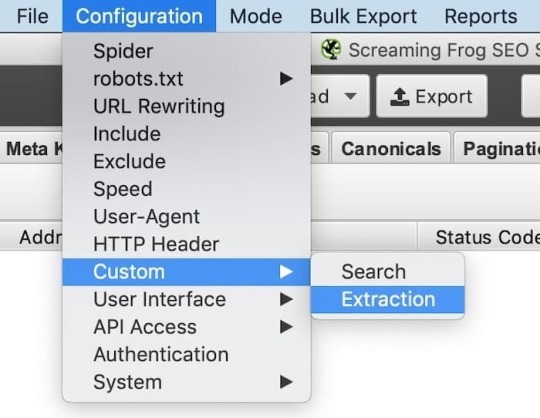
One method of doing this would be to extract the product availability property from a site’s schema markup. If you’re using Screaming Frog, you can access the Custom Extraction feature in the Configuration dropdown under Custom > Extraction,and then set up your extraction rules.

Segmenting category pages
Segmenting category pages allows you to find any categories that have hundreds of products and could benefit from being split into subcategories.
Category pages don't always have specific URL patterns, and they differ from one CMS to another, but you can look out for those that contain /category/ or /shop/. Another good option is to look for unique attributes, such as those with text showing X of Y results or pages with options for sorting product results.
Structured data markup
We saw earlier that you could scrape pages for instances of product data to identify product pages. But before we move on, we need to ensure we understand what structured data or schema markup is and how it can benefit e-commerce websites.
Product markup
Product markup provides more information about your products directly in the SERPs when your audience searches for them. Product markup can also mean your products are more eligible for rich results, such as carousels, images, and other non-textual elements.
The product schema might look something like this:

Once added, product schema allows your audience to see valuable information about your products before they even land on your page, improving your CTR! We can see Walmart has added product schema to their products in the two examples below:
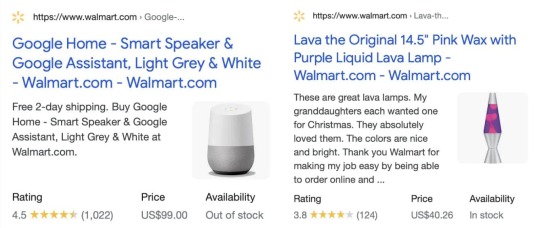
Star ratings in search results
The more positive reviews your products have, the more likely customers will be to visit your website and buy your products, especially when compared to your competitors.
Star ratings can be pulled in from your product markup through third-party tools such as Trustpilot or Reevoo, or from on-page customer reviews.

We see this when looking at these searches for Dell laptops. Realistically, which links are you more likely to click on as a customer: those with high star ratings or those with seemingly no rating at all?
Optimizing crawl budget for e-commerce
There will likely be pages on your website that are useful to existing customers, such as thank you pages after placing an order, logged-in account pages, etc. However, these pages won’t be the most important for new users looking to find you or your products on search.
It costs Google time and money to crawl our sites, so they need to budget accordingly. By managing this crawl budget, we guide search engines toward our most valuable and essential pages.
Noindexing
We don't need to index every page on our websites.
It’s entirely acceptable to meta-noindex or disallow certain pages in the robots.txt file — in fact, it’s expected. This is because indexing everything could mean that Google might not crawl all of our pages, so they might not index all of our content. This would be a problem, as it could mean some of our high-value, top-converting pages might not rank organically.
That said, we shouldn’t be noindexing vast chunks of an e-commerce website without proper research. By noindexing huge chunks, we're missing out on the ranking potential for key search behavior, e.g. locations, product sizing, etc.
Use of URL parameters
As users or owners of e-commerce websites, we’re likely familiar with URL parameters. Common areas that we see these parameters include:
Faceted navigation
Product sorting
Faceted navigation pages and product sorting options are typically blocked in robots.txt files, but it’s a good idea to find out how many of those pages Google is still serving to searchers. We can do this in our chosen crawling tool by selecting the option to ignore robots.txt rules. Alternatively, you can segment landing page session data in Google Analytics by URLs with parameters to see how many of those parameter pages are being served to users. Then, the session data will be used to show how many visits those pages are getting.
It may seem counterintuitive to do this, but these pages tend not to have unique on-page content, as they will have duplicated titles, headings, or body content, which means you could be missing out on other, more essential pages ranking for relevant keywords.
Measuring site speed across templates
With large e-commerce websites, it doesn't make sense to simply test one or two pages and take that as a site speed reading across the entire website. Each page template is built differently. One type of page can load faster than another — even if all other test parameters are the same.
Testing site speed across multiple page templates
As discussed earlier, there are many different template types that can make up a successful website. Testing a selection of pages from each of these templates is recommended to get the best picture of the load time performance of your site.
An excellent way to do this is through using the PageSpeed Insights API and connecting it to Screaming Frog or using cloud tools such as OnCrawl or Site Bulb, which will test the speed of each page on your website as it crawls.
To do this in Screaming Frog, go to “Configuration”. In “API Access”, select “PageSpeed Insights”, and there you will see fields to include the API key.

Once done, in the “Metrics” section, you can select both the device that you want to track and the reports, metrics, etc., that you are interested in extracting page speed information. In the example below, we have selected Crux Data and TTFB (Time to First Byte) and LCP and FCP data. Although the crawl may take longer to complete, this information should now appear alongside the URLs in the final crawl.

Choosing your testing location
There are various tools you can use to test your site speed, such as PageSpeed Insights, WebPageTest, and GTmetrix, and most of these do allow you to set your testing location.
It's important to test your e-commerce site from a location close to where your data centre is located (where your website is hosted), as well as one that is further away. Doing this lets you get an idea of how your real customers are experiencing your store.
If you have a CDN installed, such as Cloudflare, this is also useful, as it allows you to see how much of an impact the CDN is having on your website and how it helps your site load more quickly.
Wherever you decide to test from, remember to keep these locations the same each time you test so you can get accurate results.
Understanding caching and how it influences site speed
If your e-commerce website has caching installed, it’s even more important to test your pages more than once. This is because, on the first test, your page may not have loaded over the cache yet. Once it does, your results will likely be much faster than what you saw on your first test.
With or without caching installed, I would recommend testing each page template around three times for both mobile and desktop devices to get a good measurement and then calculate the average..
Common e-commerce website mistakes
Understanding the common problems that e-commerce websites make is valuable for learning how to avoid them on your own website, as the reasons some tactics remain underused come down to these errors.
Faceted navigation for e-commerce
Whatever your e-commerce site sells, it should be easy to navigate, with sensible menus and navigation options that clearly tell visitors what they will see when they click.

You can see this on the Boohoo website, a prominent fashion retailer in the UK. This image shows the women's dresses navigation, but you can see how it is broken down by type of dresses, dresses by occasion, colour, how they fit, and even by current fashion trends. Users are able to navigate directly to the subcategories they need.
Good website architecture matters
The importance of good architecture cannot be underestimated and should be centered around the core actions you want people to complete. Ideally, it would be best if you attempted to set up a site with the homepage, followed by the subsequent categories, subcategories, and then the products underneath.
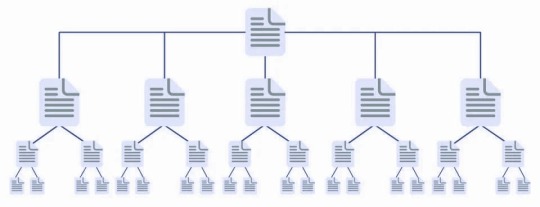
Boohoo has followed this same ideology with their architecture — as trends change and new lines of dresses are added, they can quickly expand and edit the architecture as needed.
Keeping it simple and scalable is the key to setting up good architecture. As your store grows, you will likely add more categories and products, so you need to be able to do this efficiently. You should attempt to keep important pages less than three clicks from the homepage and implement keyword research processes to create highly relevant page URLs and subdirectories.
You want people to buy your products, so don't make it difficult for them. You can then have other areas on the site for content silos and blogs that link to the various categories and products around the site.
Creating effective product pages
The product page design shouldn't detract from the shopping experience, and the product information should be as "friendly" and accessible as possible.
Try to use the product information you have available in your Product Information Management (PIM) system. Ensure that your sizes, measurements, colors, prices, and other details are easy to find, read, and understand. These details are even more vital if you happen to sell products that others also offer. If you're not including any sizes, but your competitors are, you're increasing your chances that potential customers can choose to buy from them instead. If you’re targeting multiple countries, consider whether you need to include your measurements in imperial, metric, or both. Information should be localized where relevant.
Some top ways to ensure you always include enough information and avoid thin content on your product pages are to:
Start with a 50-100 word introduction: Think about what the product does and who needs it? One way to do this can be seen in the example from Apple below.
List the critical features and technical specifications in bullet format.
Include a “deep dive” section: Write a detailed product description with use cases, relevant awards the product may have won, benefits of the product, images of the product in use, and any FAQs.
Make use of user-generated content such as customer photos and reviews.
End with a 50-100 word conclusion: Summarize the product and use a call to action to encourage your customers to make the purchase.

Including enough information can be the difference between whether or not you make the sale or whether a customer purchases from a competitor.
Utilizing FAQ content to sell more products
People undoubtedly have questions about your products. If customers can't find the answers they need on your website, they’ll search elsewhere. They're likely to buy from that website when they find the answers.
You can rectify this by having a general FAQ section on your website. This is where you would answer questions about website security, shipping and return policies, etc. When it comes to product-specific questions, these should be answered on the product pages themselves.
The need to monitor out-of-stock products
There can be many reasons why a product is out of stock, yet the page is still live on an e-commerce site, including:
Seasonality
Limited product releases
The store is waiting on more inventory
Ultimately, out-of-stock products can lead to customer frustration. Unsatisfied customers and a poor user experience — on top of the SEO implications of so many unuseful pages — result in fewer purchases and, ultimately, a poor-performing e-commerce store.
In summary
There are many ways that the performance of an e-commerce website can be optimized and analyzed, and these are just a few. While they may be less common, they can allow you to get additional data, which, once acted upon accordingly, can help you to outperform others in your market.
0 notes
Text
LENTION USB C Hub with 4K HDMI, 3 USB 3.0, SD 3.0 Card Reader Compatible 2021-2016 MacBook Pro 13/15/16, New iPad Pro/Mac Air/Surface, More, Multiport Stable Driver Dongle Adapter (CB-C34, Space Gray)
LENTION USB C Hub with 4K HDMI, 3 USB 3.0, SD 3.0 Card Reader Compatible 2021-2016 MacBook Pro 13/15/16, New iPad Pro/Mac Air/Surface, More, Multiport Stable Driver Dongle Adapter (CB-C34, Space Gray)
Price: (as of – Details) Key Features: Dual-card reading and writing on SD and Micro SD cards up to UHS-I (104MB/s)4K(3840×2160)@30Hz HDMI PerformanceData transfer speed up to 5Gbps for the USB 3.0 portsUnibody Aluminum Alloy Casing with Ionized FinishLED Indicator Device Compatibility (Partial List): MacBook Pro 2020 2019 2018 2017 2016 / MacBook Air 2020 2019 2018 / MacBook 12 Dell XPS 13 /…
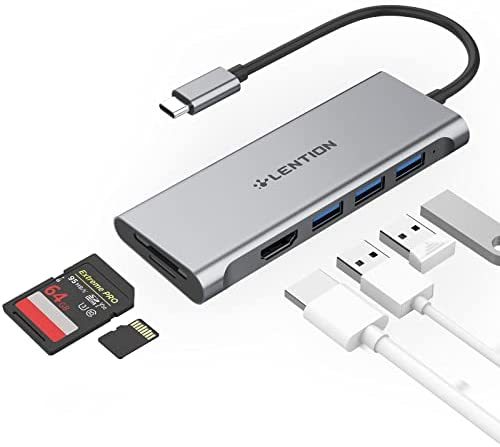
View On WordPress
0 notes
Text
Automation System Integration
Three Significant Advantages of Automation System Integration
Businesses all around the world are being forced to embrace digital systems as a result of the technological revolution. Previously, businesses were hesitant to adopt new technology. Typically, these were small-scale initiatives. Many of them gained confidence in their abilities to adapt new technologies over time, and they completed a complete digital transition. However, when a company has several branches, it can be challenging to get all of the systems to function together. As a result, it's critical that we define the many advantages of automation system integration, or the act of connecting and re-harmonizing modules.
What Is Automation System Integration and How Does It Work?
The process of connecting multiple systems and applications is referred to as system integration. Automation system integrators integrate automated systems, offering direct lines of communication that allow plant equipment to connect more effectively with operators.
Automated systems integration has numerous advantages, especially in industries that rely on information technology, computer networking, and automated machinery. These fields can improve their efficiency by integrating automation systems.
Integration helps you make your systems more robust, in addition to making equipment interoperable with the Internet of Things (IoT). Efforts to better integrate your systems and appliances will put you ahead of the competition. Additionally, because integrated equipment may share information, the integration will make your automated manufacturing processes considerably more efficient.
3 Significant Advantages of Automation System Integration
In any firm, implementing a new software system may be a time-consuming and labor-intensive procedure. Is it really worth tampering with your company's post-implementation balance?
There are numerous drawbacks to operating various software applications without integrating them. System integration is becoming increasingly important as automation technology progresses and the associated requirement to simplify procedures for better management. As a result of a completely integrated system, your operations will be streamlined, expenses will be cut, and efficiency will be improved. So far, we've looked at some of the advantages of system integration and how it can help with unstructured systems. Let's have a look at them together!
1- Accessibility, Accuracy, And Coordination
Accessibility, accuracy, and coordination are the first three factors to consider. The systems integration process, in most circumstances, entails merging data from numerous sources and storing it in a single location. As a result, there's no need to spend time manually syncing data across numerous computers. When one subsystem edits data, all other subsystems are automatically updated. As a result of system integration, data is instantly available and accessible in real time. Furthermore, automatic data updating and synchronization can considerably increase accuracy by reducing or even eliminating the possibility of users interacting with obsolete data. Because all subsystems have access to the most up-to-date data, all users can collaborate more effectively, resulting in improved cooperation. The less complicated the system, the better.
2- Providing insight into performance
Data volumes are increasing, making it increasingly difficult to maintain track of a company's performance, particularly when data is scattered across numerous departments or subsystems. It takes time to create reports from the results of the analytics. You may need to run repeated imports and exports to guarantee that there are no discrepancies. You have access to all important data at all times with an integrated system, and the efficiency of each department can be analyzed via a central dashboard. You may access data on demand thanks to a dashboard embedded into the central data vault. As a result, having instant access to relevant data allows you to undertake analysis and performance reporting in a more efficient manner.
3- Security And Scalability
Integrated systems are becoming more reliant on cloud storage as a result of technological developments in data storage. Because each subsystem has its own storage and processing platform for installation, resources must be allocated properly. Furthermore, to support increasing data volumes, each subsystem's capacity must be raised separately. This replication is eliminated with an integrated system. As needed, all subsystems can make use of shared resources. If your company need more storage or processing capabilities, cloud service providers can simply accommodate your request. As a result, the fundamental benefit of integration is scalability.
In terms of security, assailants find it difficult to penetrate all subsystems in isolated systems at the same time, especially if the system is large.
Final Thoughts
Hopefully, the primary benefits we've explored thus far have given you a clearer understanding of why a business needs system integration. Integration of automation systems allows you to use the best-of-breed systems you're most familiar with while also taking use of the additional capabilities they bring when combined. Integrating systems also eliminates the requirement for data management and storage. It has a secure architecture and a centralized database, making it scalable and reliable. Improved data collecting and retrieval methods, as well as other advantages, help businesses run more efficiently and save money. You can improve productivity, collaboration, and insights while also driving performance and results across the entire organization.
Easy Biz Tech is a company that specializes in integrated systems.
0 notes
Text
New Post has been published on Spearfishing HQ
New Post has been published on http://spearfishinghq.com/2017/08/22/dive-masks-basics/
Dive Masks Basics: Everything you already learned (or should have) in your open water course
This is a basic primer on all of the features of modern dive masks. I will explain these features and how they can benefit you. Check out upcoming posts for recommendations of specific models. This article covers:
The purpose of dive masks
An explanation of the soft skirt that holds the mask to the face
The different lens and glass types
What to look for in the strap adjustment mechanism
A quick reminder of how to prepare new masks before diving
Let’s Introduce Modern Dive Masks
Masks are an essential part of dive equipment mostly because we can’t see clearly underwater. Some animals such as seals and sea lions can see well above and below water. However, humans need something to trap a small amount of air against the eyes. Also, the dive mask prevents water from entering the nose or eyes, which can be pretty uncomfortable, especially in salt water.
Let’s Just Use Goggles!
If you are swimming on or near the surface a pair of swim goggles that only cover the eyes will work perfectly for allowing you to see and protect your eyes. However, once you start to descend the water pressure will quickly squeeze the goggles to your face and you will be unable to equalize them, which can cause damage. This is why all dive masks enclose the nose, allowing you to blow air into the mask and equalize it. You can not use swim googles for diving!
Injury resulting from a squeeze. This can happen if a pair of goggles or a dive mask is not equalized underwater.
Keep the Nose Covered. Got It!
In order to attach the lens to the face you will need a soft material to make a comfortable and waterproof seal that encloses the nose and eyes. The early dive masks of the 1950’s used rubber but today most masks use a silicone based material which is a bit softer and more comfortable. Some of the less expensive masks, usually sold as snorkel kits in big box retailers use a plastic or PVC based material for the mask skirt and is of lower quality than the silicone option in terms of comfort and pliability. Some brands are advertising ultra-soft silicone skirts. There will continue to be advancements just keep in mind the purpose of the skirt is to make a comfortable and watertight seal and be sure your mask does just that.
Skirts also come in clear or colored. Clear skirts allow more light into the mask and it’s even possible to see strong shadows through them, allowing you to turn your attention to something in your peripheral. Black or colored skirts are better at blocking refracted light which might help prevent a glare if diving in shallow clear water on a sunny day. With my clear mask sometimes I cup my hands around my mask like I’m peering into a window if I’m trying to see out in the blue or into a shadowy place to block the light. One isn’t really better for most applications so you will just have to try both and decide which one works for you.
T For Tempered
Dive masks should have tempered glass for the lens or lenses. Tempered glass is stronger and is safer when it breaks.
Most dive masks come in one or two pane options, or more simply, one big lens or two smaller lenses. One difference between the two is that replacement prescription lenses are usually only offered for the two-lens style, and the frameless style masks usually are offered in the single pane style. Another style you may see in the side window mask. This mask has glass lenses on the side of the mask to allow a wider field of vision, this is usually found on large masks. There isn’t an inherent advantage to any mask based on number of lenses alone.
Dive masks can come with colored or clear skirts and with a different number of lenses.
Masks can have a plastic frame that pin the glass lenses in place to the skirt or they can be ‘frameless’ where the glass is bonded directly to the skirt. The best mask is the mask that fits you the best, but frameless options tend to have two advantages. One is a lower internal airspace volume, making clearing the mask of water easier, and the lens tends to sit closer to the eyes which can give a slightly wider field of vision.
Most dive masks use a standard glass which puts a very slight green tint to it. Some manufactures are offering ultra-clear glass which has a lower iron content to remove some of the green tint and filter less light. Some brands of low-iron glass allow as much as 92% of light to pass through. As much of the light is filtered underwater it’s an advantage to have a clearer mask, however, in my opinion, it is a very slight difference and the standard glass will work fine.
Along the lines of offering clearing vision, some brands are now offering anti-reflective coatings on the mask lenses. They claim that they reduce the amount of light reflected by the glass and allows that light to pass through to your eyes. This technology is already widely used on prescription eyewear. Optometrist Gary Heiting, explains at All About Vision that prescription lenses with modern anti-reflective materials can allow 99.5% of available light to reach the eye.
youtube
Mirrored or colored lenses are other options that are sometime preferred by spearfisherman. The mirrored lenses prevent the fish from being able to see your eyes which some spearos find to be an advantage. Mirrored lenses limit some light from entering the mask which may be useful in shallow clear water to stop some of the glare from refracted light, however, it will make things seem darker in situations where there already isn’t much light available.
The Cressi Big Eyes Evolution comes in a mirrored option
Amber or colored lenses are designed to provide more contrast by filtering certain colors of light. The strongest effect can be seen in greenish water with low visibility. In my opinion, I think that there is already very limited light underwater and I want a mask that allows as much light as possible and I avoid any mask that blocks or filters light.
Let’s Keep It All on the Head
The dive mask is secured to the head by a strap. It is usually made out of silicone but you can buy an aftermarket neoprene covers or neoprene and Velcro straps if you would like. They don’t get tangled in long hair as easily as the silicone does.
The more important part is how the strap attaches to the mask. Masks have an adjustment mechanism on the side of the mask to allow you to adjust the strap to fit your head. The adjustment can attach to the side of the plastic frame or it can be formed directly onto the silicone.
Generally, it is better if the strap buckle is attached to the silicone. The silicone stretches and moves making it less likely to break. Also, if the strap moves for any reason, for example you move your snorkel that is attached to the strap, it is less likely to transfer the motion and move your mask out of position on your face.
One final consideration on adjusting the mask strap is how easily it is to adjust. Most buckles have a lever or button to loosen the strap and to tighten you simply pull on the loose tabs. The important thing is that it is easy for you to tighten or loosen the strap while the mask is in place on your head. You shouldn’t have to pull it off to adjust it.
Mask Preparation
All new masks need to be prepared before use. The inside of the mask will fog and then you won’t be able to see anything. You can prepare the mask by scrubbing it with a slightly abrasive cleaner such as toothpaste. There are commercial products available for just that purpose as well. Just put in some cleaner on the inside of the lens and rub it around with your finger for at least 5 minutes.
Another way, and my personal preference, is to burn the inside of the lens with a lighter. Just put the flame a few inches from the inside of the glass and move it around to cover it all. Just make sure you don’t heat the silicone as it can be damaged. Also, be careful of the glass because it can heat up quickly.
You may need to do one of these initial preparations a few times before you have success. Also, never forget to defog the mask just before entering the water. You can use a commercial product for this as well. Also, a 50-50 mix of baby soap and water will work well, and of course the classic is to just spit in the mask then quickly rinse it just before entering the water.
Commercial scrubs and defog like this one are available as well as using house hold cleaners
References
http://www.manfish.ca/the-evolution-of-the-modern-diving-mask.html
http://www.scubadiving.com/gear/masks/if-mask-fits
http://www.allaboutvision.com/lenses/anti-reflective.htm
https://www.verywell.com/are-anti-reflective-coatings-worth-the-extra-cost-3421899
https://www.pilkington.com/en-gb/uk/products/product-categories/special-applications/pilkington-optiwhite#performancedata
0 notes
Text
Price: [price_with_discount] (as of [price_update_date] - Details) [ad_1] Seagate manufactures hard drives that specifically address the demand for hyperscale cloud scalability. As the flagship of the Seagate® X class, the Exos® X18 enterprise hard drives are the highest-capacity hard drives in the fleet.Maximum Storage Capacity for Highest Rack Space EfficiencyMarket-leading 18TB HDD offering the highest capacity available for more petabytes per rackHighly reliable performance with enhanced caching, making it the logical choice for cloud data center and massive scale-out data center applicationsHyperscale SATA model tuned for large data transfers and low latencyPowerBalance™ feature optimizes Watts/TBMaximize total cost of ownership savings through lower power and weight with helium sealed-drive designProven helium side-sealing weld technology for added handling robustness and leak protectionDigital environmental sensors to monitor internal drive conditions for optimal operation and performanceData protection and security- Seagate Secure™ features for safe, affordable, fast, and easy drive retirementProven enterprise-class reliability backed by 5-year limited warranty and 2.5M-hr MTBF rating Scalable hyperscale applications/cloud data centers Massive scale-out data centers Big data applications High-capacity density RAID storage Mainstream enterprise external storage arrays Distributed file systems, including Hadoop and Ceph Enterprise backup and restore- D2D, virtual tape Centralized surveillance [ad_2]
0 notes
Text
Price: [price_with_discount] (as of [price_update_date] - Details) [ad_1] Stands for "Compact Disc premium Brand Recordable." CD-R discs are blank CDs that can record data written by a CD burner. The word "recordable" is used because CD-Rs are often used to record audio, which can be played back by most supported CD players. However, many other kinds of data can also be written to a CD-R, so the discs are also referred to as "writable CDs." Unbeatable performance Data -Photo - Movies - Music your memories [ad_2]
0 notes
Text
Price: [price_with_discount] (as of [price_update_date] - Details) [ad_1] SAMSUNG T7 Portable SSD 2TB - Up to 1050MB/s - USB 3.2 External Solid State Drive, Blue (MU-PC2T0H/AM) SAMSUNG RECOMMENDS users to download the latest firmware update via the included Portable SSD Software 1.0 to ensure optimal performance Data transfer speed may vary depending on the user's PC environment and the types of data being transferred. USB 3.2 Gen2 and UASP support are required for maximum transfer speed (1,050MB/s) SAMSUNG RECOMMENDS the usage of the included USB Type-C to C and USB Type-C to A cables. Non-original cables may cause performance degradation due to the varying internal resistance and maximum allowable currency BUILT STRONG & SECURE: Shock-resistant and withstands drops from 6ft.ADVANCED HEAT CONTROL: DYNAMIC THERMAL GUARD (DTG) TECHNOLOGY protects the T7 (T7 Touch) from overheating by automatically slowing down the data transfer if necessary. DTG technology enhances product safety and reliability by preventing the T7 (T7 Touch) from reaching an excessively high temperature.PASSWORD SECURITY [ad_2]
0 notes
Text
Price: [price_with_discount] (as of [price_update_date] - Details) [ad_1] *SAMSUNG RECOMMENDS users to download the latest firmware update via the included Portable SSD Software 1.0 to ensure optimal performance Data transfer speed may vary depending on the user’s PC environment and the types of data being transferred. USB 3.2 Gen2 and UASP support are required for maximum transfer speed (1,050MB/s)** **SAMSUNG RECOMMENDS the usage of the included USB Type-C to C and USB Type-C to A cables. Non-original cables may cause performance degradation due to the varying internal resistance and maximum allowable currency BUILT STRONG & SECURE: Shock-resistant and withstands drops from 6ft. ADVANCED HEAT CONTROL: DYNAMIC THERMAL GUARD (DTG) TECHNOLOGY protects the T7(T7 Touch) from overheating by automatically slowing down data transfer if necessary. DTG technology enhances product safety and reliability by preventing the T7(T7 Touch) from reaching an excessively high temperature PASSWORD SECURITY [ad_2]
0 notes
Text
LENTION USB C Hub with 4K HDMI, 3 USB 3.0, SD 3.0 Card Reader Compatible 2021-2016 MacBook Pro 13/15/16, New iPad Pro/Mac Air/Surface, More, Multiport Stable Driver Dongle Adapter (CB-C34, Rose Gold)
LENTION USB C Hub with 4K HDMI, 3 USB 3.0, SD 3.0 Card Reader Compatible 2021-2016 MacBook Pro 13/15/16, New iPad Pro/Mac Air/Surface, More, Multiport Stable Driver Dongle Adapter (CB-C34, Rose Gold)
Price: (as of – Details) Key Features: Dual-card reading and writing on SD and Micro SD cards up to UHS-I (104MB/s)4K(3840×2160)@30Hz HDMI PerformanceData transfer speed up to 5Gbps for the USB 3.0 portsUnibody Aluminum Alloy Casing with Ionized FinishLED Indicator Device Compatibility (Partial List): MacBook Pro 2020 2019 2018 2017 2016 / MacBook Air 2020 2019 2018 / MacBook 12 Dell XPS 13 /…
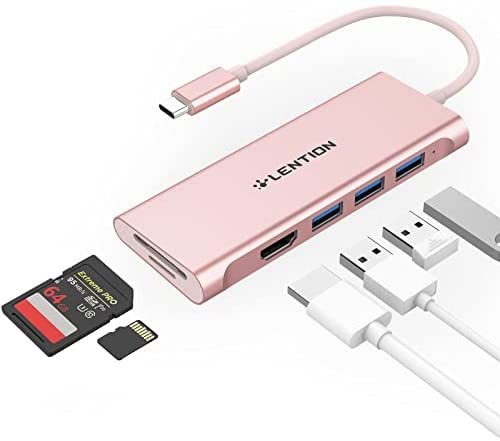
View On WordPress
0 notes